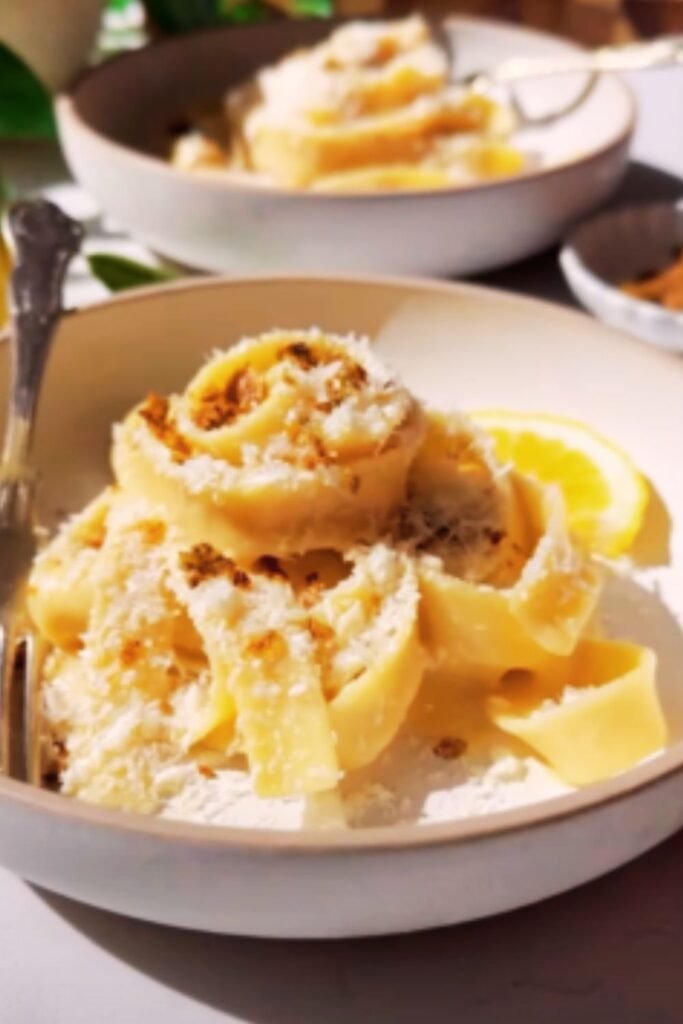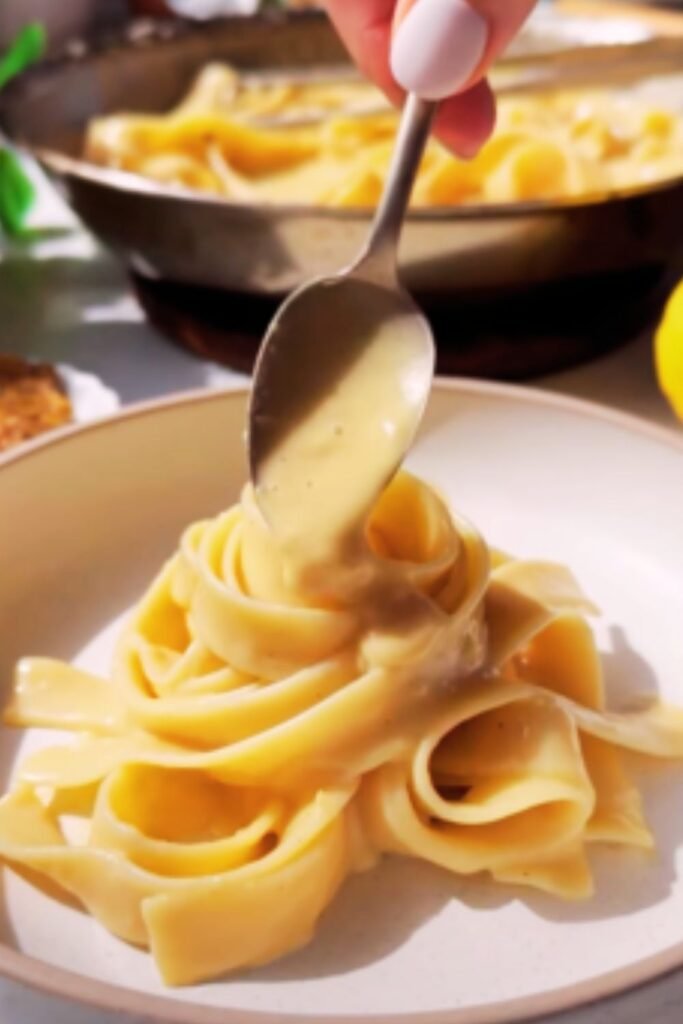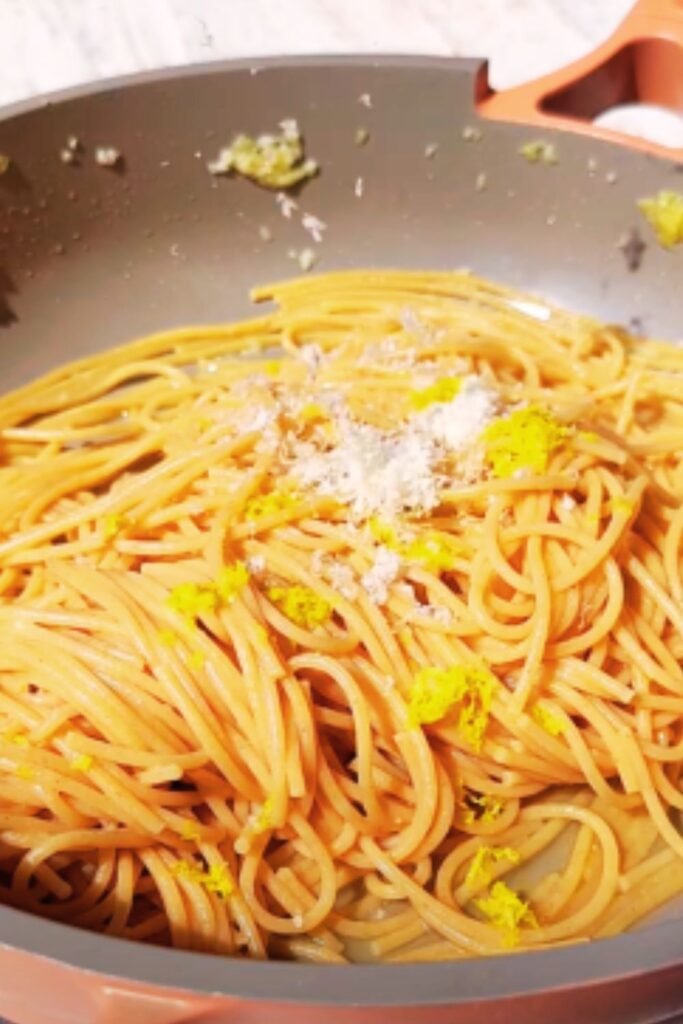Have you ever craved a pasta dish that feels like sunshine on a plate? That’s exactly what Pappardelle al Limone delivers—bright, zesty, and utterly comforting. As someone who has spent years perfecting pasta recipes in my home kitchen and during my travels throughout Italy, I can confidently say this lemon-infused pasta is a game-changer for both weeknight dinners and special occasions.
When I first encountered this dish in a small trattoria in Tuscany, I was struck by how something so simple could deliver such complex flavors. The wide ribbons of pappardelle coated in a silky, lemony sauce creates a perfect balance of richness and acidity that I’ve been obsessed with recreating ever since.
Today, I’m sharing my perfected recipe for Pappardelle al Limone that has earned rave reviews from even my most critical Italian friends. Let’s dive into this bright, bold, and beautiful pasta that will transport you straight to the sunny coasts of Italy!
What Makes Pappardelle al Limone Special?
Pappardelle al Limone stands out in the vast world of pasta dishes because of its remarkable simplicity paired with vibrant flavors. What makes this dish truly special is:
- The wide, flat pappardelle noodles that provide the perfect canvas for catching the silky sauce
- The bright, zesty lemon flavor that cuts through the richness of the cream
- The perfect balance of indulgence and freshness that satisfies any pasta craving
- Its versatility as both a quick weeknight meal and an impressive dinner party offering
The History Behind the Dish
While many assume this dish hails from the Amalfi Coast—famous for its spectacular lemons—Pappardelle al Limone actually has roots in both Tuscan and Roman cuisine. Historically, citrus has been used in Italian cooking for centuries, with lemons making their way into pasta dishes as a way to brighten heavy cream-based sauces.
The wide pappardelle noodles traditionally were paired with rich game sauces in Tuscany, but over time, lighter variations emerged that highlighted seasonal ingredients. The lemon version became popular as a spring and summer option when the bright acidity offered relief from the heat while still delivering comfort.
I’ve found that understanding the origins of this dish helps me appreciate the beautiful simplicity behind it—quality ingredients allowed to shine without unnecessary complexity.
Essential Ingredients

The beauty of Pappardelle al Limone lies in its simplicity. However, the quality of each ingredient makes all the difference in the final result. Here’s what you’ll need:
The Pasta
Pappardelle: Fresh egg pappardelle is ideal, with its wide ribbons (about 1-inch wide) that hold the sauce beautifully. If you can make your own or find fresh pasta, it’s worth it. However, high-quality dried pappardelle works wonderfully too.
The Sauce Components
- Lemons: Both the zest and juice are essential. Look for unwaxed organic lemons if possible.
- Heavy Cream: Creates the silky base of the sauce.
- Butter: Unsalted butter adds richness and helps emulsify the sauce.
- Parmigiano-Reggiano: The authentic aged cheese provides saltiness and depth.
- Garlic: Just a hint, minced very finely or made into a paste.
- Fresh Herbs: Basil or mint adds a wonderful aromatic element.
- Black Pepper: Freshly ground is non-negotiable.
- Salt: Sea salt or kosher salt for pasta water and seasoning.
- Olive Oil: A high-quality extra virgin olive oil makes a difference.
Key Equipment You’ll Need
Having the right tools makes preparing this dish even more enjoyable:
- Large pasta pot for boiling pappardelle
- Microplane or fine grater for lemon zest
- Citrus juicer for extracting maximum lemon juice
- Wide, shallow pan for sauce preparation
- Wooden spoon or silicone spatula for stirring
- Tongs for transferring pasta
Detailed Recipe
Ingredients (Serves 4)
- 12 oz (340g) pappardelle pasta (fresh or dried)
- 2 large unwaxed lemons
- 3/4 cup (180ml) heavy cream
- 4 tablespoons (56g) unsalted butter
- 1 cup (100g) freshly grated Parmigiano-Reggiano, plus extra for serving
- 2 cloves garlic, very finely minced
- 1/4 cup fresh basil or mint leaves, torn or chopped
- Salt and freshly ground black pepper, to taste
- 2 tablespoons extra virgin olive oil
- 1/4 teaspoon red pepper flakes (optional)
Nutritional Information
| Nutrient | Amount per Serving |
|---|---|
| Calories | 620 |
| Protein | 18g |
| Carbohydrates | 64g |
| Fat | 34g |
| Saturated Fat | 19g |
| Fiber | 3g |
| Sugar | 4g |
| Sodium | 380mg |
| Vitamin C | 15% DV |
| Calcium | 25% DV |
Preparation Steps
- Prepare Your Ingredients
- Zest both lemons, ensuring you only get the yellow part (the white pith is bitter).
- Juice the lemons, straining out seeds. You should have approximately 1/4 cup juice.
- Grate the Parmigiano-Reggiano finely.
- Mince the garlic very finely, almost to a paste.
- Prepare your herbs by washing and chopping or tearing.
- Cook the Pasta
- Bring a large pot of water to a rolling boil.
- Add 1 tablespoon of salt (the water should taste like the sea).
- If using dried pappardelle, cook according to package instructions until al dente, usually 8-10 minutes.
- If using fresh pappardelle, it will cook much faster, about 2-3 minutes.
- Reserve 1 cup of pasta cooking water before draining.
- Prepare the Sauce
- While the pasta cooks, heat a large, wide pan over medium heat.
- Add butter and olive oil, allowing the butter to melt completely.
- Add the minced garlic and red pepper flakes (if using) and sauté for 30 seconds until fragrant but not brown.
- Pour in the heavy cream and bring to a gentle simmer.
- Add the lemon zest and reduce heat to low.
- Simmer for about 2 minutes, allowing the flavors to infuse.
- Combine Pasta and Sauce
- Transfer the cooked pasta directly to the sauce using tongs.
- Add about 1/4 cup of the reserved pasta water and toss gently to coat the noodles.
- Sprinkle in 3/4 of the grated cheese while continuing to toss.
- Add the lemon juice gradually, tasting as you go until you achieve the desired level of acidity.
- If the sauce is too thick, add more pasta water a tablespoon at a time until you reach your desired consistency.
- Finish and Serve
- Remove from heat.
- Season with salt and freshly ground black pepper to taste.
- Fold in the fresh herbs.
- Serve immediately in warmed bowls.
- Top with the remaining Parmigiano-Reggiano and additional freshly ground black pepper.
- Garnish with a few small basil or mint leaves and a tiny bit of lemon zest for presentation.
Timing and Temperature Guide
| Stage | Temperature | Time |
|---|---|---|
| Pasta Water | Rolling boil (212°F/100°C) | 8-10 mins for dried, 2-3 mins for fresh |
| Sautéing Garlic | Medium (325°F/163°C) | 30 seconds |
| Cream Reduction | Low simmer (170-180°F/77-82°C) | 2-3 minutes |
| Final Tossing | Off heat | 1-2 minutes |
My Pro Tips for Perfect Pappardelle al Limone
After making this dish countless times, I’ve discovered several tricks that elevate it from good to exceptional:
- Reserve More Pasta Water Than You Think You’ll Need The starchy water is liquid gold for creating a silky sauce that perfectly adheres to the pasta. I always save a full cup, even if I only end up using a few tablespoons.
- Balance Is Key The magic of this dish lies in finding the perfect balance between richness (cream, butter, cheese) and acidity (lemon). I recommend adding the lemon juice gradually and tasting as you go rather than adding it all at once.
- Undercook the Pasta Slightly When cooking the pappardelle, aim for even firmer than al dente—it will continue cooking in the sauce and absorb flavors better.
- Use Room Temperature Lemons You’ll get significantly more juice from room-temperature lemons compared to cold ones.
- Add Cheese Off The Heat To prevent the cheese from clumping or becoming stringy, always add it after removing the pan from heat.
- Make It Your Own While traditional recipes call for basil, I often substitute mint when I want an even brighter, more refreshing flavor profile. Both work beautifully.
- Optional Enhancement For an extra dimension of flavor, I sometimes add a splash of white vermouth to the sauce as it reduces.
Common Mistakes to Avoid

Even experienced cooks can run into challenges with this seemingly simple dish. Here are pitfalls to avoid:
- Overcooking the Pasta Soggy noodles will ruin the texture of the dish. Pappardelle should maintain its structure while still being tender.
- Curdling the Sauce Adding cold lemon juice directly to hot cream can cause curdling. Reduce the heat first and add the juice gradually while stirring.
- Skimping on the Zest The zest contains aromatic oils that give this dish its distinctive fragrance. Don’t be shy with it!
- Using Pre-Grated Cheese Pre-packaged grated cheese often contains anti-caking agents that prevent proper melting. Always grate your own.
- Rushing the Process While this is a quick dish, each step deserves attention. Allow time for the cream to reduce and for the flavors to infuse properly.
- Overseasoning Early Wait until the end to adjust salt levels, as the cheese and pasta water will add saltiness as the dish comes together.
Variations and Dietary Adaptations
The classic Pappardelle al Limone can be adapted to accommodate different dietary needs:
Dairy-Free/Vegan Option
- Replace heavy cream with cashew cream or full-fat coconut milk
- Use olive oil instead of butter
- Substitute nutritional yeast or a vegan parmesan alternative for the cheese
- Add 1/2 teaspoon of white miso paste for umami depth
Gluten-Free
- Use gluten-free pappardelle (corn and rice based varieties work well)
- Ensure your work surface is free from cross-contamination
- Cook gluten-free pasta in plenty of water to prevent sticking
Lighter Version
- Substitute half the cream with the same amount of reserved pasta cooking water
- Reduce butter to 2 tablespoons
- Increase the lemon zest for flavor without added calories
Protein Additions
- Fold in 8 oz (225g) of sautéed shrimp
- Add 2 cups of shredded rotisserie chicken
- Include 8 oz (225g) of lightly seared scallops
Serving Suggestions

Pappardelle al Limone works beautifully as both a standalone dish and as part of a larger Italian feast. Here’s how I like to serve it:
Accompanying Sides
- A simple arugula salad with olive oil, lemon juice, and shaved Parmigiano-Reggiano
- Roasted asparagus or broccolini with garlic and red pepper flakes
- Heirloom tomato salad with fresh basil and balsamic glaze
- Crusty Italian bread for soaking up any remaining sauce
For a Complete Italian Meal
- Start with Caprese skewers or bruschetta
- Serve the pappardelle as a primo (first course)
- Follow with a light secondo of grilled fish or chicken
- End with a simple dessert like lemon sorbet or panna cotta
Beverage Pairings
- Sparkling water with a twist of lemon
- Italian lemonade or San Pellegrino Limonata
- Fresh mint iced tea
- Non-alcoholic spritzer with elderflower cordial and fresh citrus
Storing and Reheating
While Pappardelle al Limone is best enjoyed immediately after preparation, leftovers can be managed:
Storage
- Allow leftovers to cool completely before refrigerating in an airtight container
- Will keep for up to 2 days in the refrigerator
- Not recommended for freezing as the sauce will separate and the pasta texture will deteriorate
Reheating
- Add 1-2 tablespoons of water or cream to the pasta
- Reheat gently in a pan over low heat, stirring frequently
- Avoid microwave reheating if possible, as it can make the sauce separate and the pasta rubbery
- Add a small amount of fresh lemon zest and a sprinkle of Parmigiano-Reggiano after reheating to refresh the flavors
Seasonal Adaptations
One of the things I love about this recipe is how it can be adapted throughout the year:
Spring
- Add fresh peas and mint for a springtime variation
- Incorporate tender asparagus tips, blanched and shocked
Summer
- Add quartered cherry tomatoes and fresh basil
- Include a handful of sweet corn kernels for natural sweetness
Fall
- Incorporate roasted butternut squash cubes
- Add sage leaves crisped in butter as a garnish
Winter
- Fold in roasted garlic and a hint of nutmeg
- Add some wilted spinach for extra nutrition and color
Q&A Section
Q: Can I use a different pasta shape if I can’t find pappardelle? Absolutely! While the wide, flat shape of pappardelle is ideal for catching this creamy sauce, other wide pasta shapes like fettuccine or tagliatelle work wonderfully. Even linguine can be substituted in a pinch. The key is to choose a pasta with enough surface area to hold the delicate sauce.
Q: How can I make this dish ahead for a dinner party? For dinner parties, I recommend preparing components separately: cook the pasta until very al dente (2 minutes less than package instructions), toss with a little olive oil, and refrigerate. Make the sauce up until adding the lemon juice, then refrigerate separately. When ready to serve, warm the sauce, cook the pasta for 1 minute in boiling water to reheat, then combine with the sauce, adding lemon juice and fresh herbs at the last minute.
Q: Why does my sauce sometimes curdle or become grainy? Curdling typically happens when acid (lemon juice) is added to dairy at too high a temperature. To prevent this, make sure your cream mixture has cooled slightly before adding lemon juice, add the juice very gradually while constantly stirring, and keep the heat low. If it does start to curdle, sometimes a splash of pasta water and vigorous whisking can help re-emulsify the sauce.
Q: Is there a trick to getting the most juice from lemons? Yes! I roll my lemons firmly on the countertop using the palm of my hand before juicing them. This breaks down some of the internal membranes and releases more juice. Using room temperature (not cold) lemons also helps significantly. Finally, a handheld citrus press will extract more juice than simply squeezing by hand.
Q: How do I know when the pasta is perfectly al dente? Perfect al dente pasta has a slight resistance when bitten—there should be a tiny speck of uncooked pasta visible at the very center. For this dish specifically, I recommend removing the pasta from the water about 1 minute before it reaches this stage, as it will continue cooking in the hot sauce.
Q: My sauce seems too thin, how can I thicken it? If your sauce is too thin, there are several options: continue simmering it gently to reduce further, add more freshly grated cheese off the heat while tossing, or create a slurry of 1 teaspoon cornstarch mixed with 1 tablespoon cold water and add it to the simmering sauce. However, remember that the sauce will naturally thicken slightly as it cools.
Q: Can I add vegetables to make this a complete meal? Definitely! This dish welcomes light vegetable additions. Sautéed zucchini, sweet peas, asparagus tips, or even wilted spinach complement the lemony cream sauce beautifully. For heartier vegetables like broccoli or cauliflower, blanch them before adding to the dish to ensure they’re properly cooked.
Final Thoughts
There’s something magical about the way Pappardelle al Limone balances richness and brightness, comfort and elegance. It’s a dish that feels special enough for celebrations yet simple enough for everyday cooking. The beauty lies in its honest ingredients and the care taken in bringing them together.
When I serve this to friends or family, I’m always reminded of that first taste in Tuscany—the way the silky sauce coated each strand of pasta, the perfect harmony of cream and citrus, and the undeniable satisfaction that comes from a perfectly executed pasta dish.
Whether you’re an experienced cook or just beginning your culinary journey, I hope this recipe brings as much joy to your table as it has to mine. Buon appetito!


